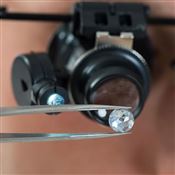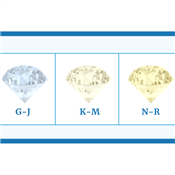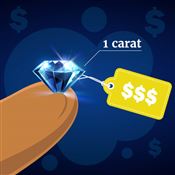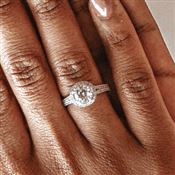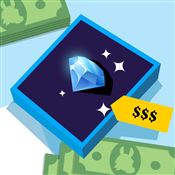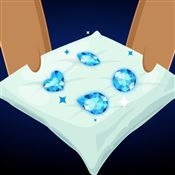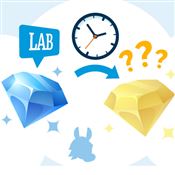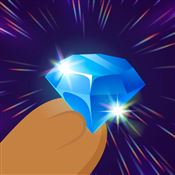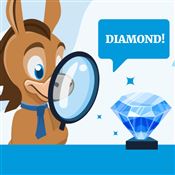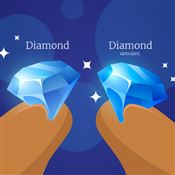Diamond Price Chart
Are you getting a fair price? See the current price of diamonds. Learn how diamond pricing works, trends and compare 1, 1.5, 2, and 3 carat diamonds.
 |
Before shopping for an engagement ring, it's important to understand the basics of diamond pricing.
This quick 10-minute guide is packed with:
- Tons of diamond price charts with the current market price of diamonds
- Secrets and tips on how to get the best value for your money
CreditDonkey comparative diamond analysis is an estimate of a diamond's retail value based on the 4Cs and current market trends. Use this tool to make sure you're not overpaying for a diamond.
How Much Do Diamonds Cost?
Before you get into the deep dive, here are the current 2021 diamond prices you can expect. The recommended price indicates where you get the best balance of price, quality, and beauty in a diamond.
| Carat Weight | Diamond Price per Carat | Total Price | Recommended Price (Best Value) |
|---|---|---|---|
| 0.25 carat | $800 - $4,000 | $200 - $1,000 | $500 |
| 0.50 carat | $1,000 - $8,000 | $500 - $4,000 | $1,300 |
| 0.75 carat | $1,300 - $9,000 | $1,000 - $6,800 | $2,800 |
| 1.0 carat | $2,000 - $16,000 | $2,000 - $16,000 | $5,500 |
| 1.25 carat | $2,400 - $19,000 | $3,000 - $24,000 | $7,500 |
| 1.5 carat | $2,670 - $20,000 | $4,000 - $30,000 | $11,000 |
| 2.0 carat | $4,000 - $35,000 | $8,000 - $70,000 | $19,000 |
| 2.5 carat | $4,800 - $36,000 | $12,000 - $90,000 | $30,000 |
| 3.0 carat | $7,000 - $66,700 | $20,000 - $200,000 | $45,000 |
| Carat Weight | Diamond Price per Carat | Total Price | Recommended Price (Best Value) |
|---|---|---|---|
| 0.25 carat | $800 - $3,200 | $200 - $800 | $350 |
| 0.50 carat | $800 - $5,000 | $400 - $2,500 | $1,000 |
| 0.75 carat | $1,300 - $5,330 | $1,000 - $4,000 | $2,000 |
| 1.0 carat | $1,400 - $12,000 | $1,400 - $12,000 | $4,000 |
| 1.25 carat | $2,000 - $12,800 | $2,500 - $16,000 | $7,000 |
| 1.5 carat | $2,330 - $13,330 | $3,500 - $20,000 | $9,000 |
| 2.0 carat | $3,250 - $16,000 | $6,500 - $32,000 | $16,000 |
| 2.5 carat | $4,000 - $22,000 | $10,000 - $55,000 | $30,000 |
| 3.0 carat | $5,000 - $33,300 | $15,000 - $100,000 | $38,000 |
| Carat Weight | Diamond Price per Carat | Total Price | Recommended Price (Best Value) |
|---|---|---|---|
| 0.25 carat | $800 - $1,800 | $200 - $450 | $270 |
| 0.50 carat | $800 - $2,000 | $400 - $1,000 | $750 |
| 0.75 carat | $1,000 - $2,400 | $750 - $1,800 | $850 |
| 1.0 carat | $1,000 - $4,000 | $1,000 - $4,000 | $1,600 |
| 1.25 carat | $1,200 - $4,400 | $1,500 - $5,500 | $2,000 |
| 1.5 carat | $1,333 - $4,667 | $2,000 - $7,000 | $2,500 |
| 2.0 carat | $1,600 - $6,000 | $3,200 - $12,000 | $3,800 |
| 2.5 carat | $1,680 - $6,000 | $4,200 - $15,000 | $5,800 |
| 3.0 carat | $2,170 - $8,333 | $6,500 - $25,000 | $9,000 |
As you can see, there is a huge price range. But it doesn't mean you need to spend top dollar for to get a good diamond. Our recommended price for best value isn't anywhere near the high point. But you will still get a diamond that looks just as good. Stick around to the end to learn how.
How Diamond Prices Work
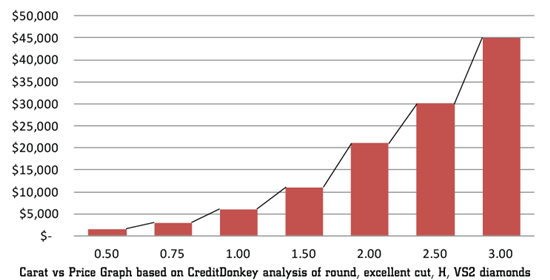 |
| Diamond Price vs Carat © CreditDonkey |
Diamonds prices are determined by many factors. We'll go over the main ones below. In a nutshell, a diamond is valued based on its quality and how rare it is.
Larger diamonds are harder to find. That's why the cost increases exponentially when you move up in carat weight.
Likewise, the more perfect a diamond is, the rarer it is. A flawless and colorless diamond will cost a lot more than a diamond with slight imperfections - even if there's no visible difference.
The 4Cs - carat, cut, color, and clarity - is a universal grading system to determine the quality of a diamond - and ultimately what it's worth.
PRO TIP: If you want a cheaper, more sustainable alternative to regular diamonds, check out Brilliant Earth. They have a great selection of natural diamonds and lab-grown diamonds. Lab-grown diamonds are identical to natural diamonds, except they're more affordable and easier on the environment.
Value and Price Are Not the Same
One important thing to understand is that a diamond's value and price are not the same thing.
The diamond's value depends on factors like the 4Cs, fluorescence, shape (and some others). These are a diamond's physical qualities that determine how much they're worth. Rarer, high-quality stones will be worth more. Poorer-quality stones are worth less.
But a diamond's final price largely depends on how much the retailer sells it for.
- High-end jewelers (like Tiffany and Cartier) can sell at sky-high prices.
- Big-box jewelers (like Kay and Zales) also have higher markups because of their physical overhead.
- Online diamond retailers (like Brilliant Earth) can sell at closer to wholesale prices.
Below, we have more detailed diamond price charts for popular carat weights.
1 Carat Diamond Price Charts
1 carat diamonds are the most popular choice for engagement rings. Just how much does it cost?
Here are the average current retail prices of 1 carat diamonds. You can use them as a guideline for what diamonds should cost.
| IF | VVS1 | VVS2 | VS1 | VS2 | SI1 | SI2 | |
|---|---|---|---|---|---|---|---|
| D | $15,603 | $11,486 | $9,793 | $8,711 | $7,831 | $6,140 | $4,974 |
| E | $11,228 | $10,134 | $8,958 | $8,247 | $7,480 | $5,914 | $4,755 |
| F | $10,194 | $9,157 | $8,340 | $7,918 | $7,155 | $5,834 | $4,685 |
| G | $8,782 | $7,948 | $7,502 | $7,257 | $6,734 | $5,607 | $4,519 |
| H | $7,280 | $6,955 | $6,681 | $6,475 | $6,247 | $5,334 | $4,361 |
| I | $5,888 | $5,697 | $5,394 | $5,202 | $4,940 | $4,501 | $3,810 |
| J | $5,087 | $4,780 | $4,548 | $4,468 | $4,331 | $3,917 | $3,504 |
| K | $4,369 | $3,810 | $3,728 | $3,658 | $3,448 | $3,193 | $2,927 |
| IF | VVS1 | VVS2 | VS1 | VS2 | SI1 | SI2 | |
|---|---|---|---|---|---|---|---|
| D | $9,875 | $8,050 | $7,538 | $6,883 | $5,791 | $4,456 | $3,742 |
| E | $7,652 | $7,589 | $6,330 | $5,860 | $5,449 | $4,410 | $3,392 |
| F | $7,112 | $6,024 | $5,864 | $5,549 | $5,295 | $4,208 | $3,415 |
| G | $6,166 | $5,470 | $4,728 | $5,019 | $4,762 | $4,125 | $3,315 |
| H | $5,541 | $4,423 | $4,428 | $4,121 | $3,789 | $3,689 | $3,145 |
| I | $4,756 | $3,929 | $3,636 | $3,815 | $3,528 | $3,255 | $2,798 |
| J | $3,564 | $2,996 | $2,924 | $2,853 | $2,828 | $2,612 | $2,482 |
| K | $3,473 | $2,844 | $2,699 | $2,533 | $2,594 | $2,232 | $2,446 |
| IF | VVS1 | VVS2 | VS1 | VS2 | SI1 | SI2 | |
|---|---|---|---|---|---|---|---|
| D | $6,851 | $5,824 | $5,685 | $5,663 | $5,007 | $3,947 | $3,180 |
| E | $6,360 | $6,038 | $5,492 | $4,946 | $4,738 | $3,852 | $3,125 |
| F | $6,070 | $5,481 | $4,953 | $4,709 | $4,493 | $3,656 | $2,928 |
| G | $5,366 | $5,120 | $4,900 | $4,665 | $4,339 | $3,521 | $2,785 |
| H | $4,908 | $4,407 | $4,116 | $3,925 | $3,596 | $3,279 | $2,639 |
| I | $3,121 | $3,494 | $3,442 | $3,424 | $3,050 | $2,924 | $2,312 |
| J | $3,165 | $3,070 | $2,851 | $2,699 | $2,573 | $2,233 | $2,103 |
| K | $2,282 | $2,597 | $2,506 | $2,266 | $2,086 | $2,098 | $1,791 |
Keep in mind that these are the average prices of loose diamonds. On top of this, you need to add in the cost of the ring itself too, which is typically $250 - $2,000, depending on the style you pick.
See our detailed guide on 1-carat diamond prices for price charts of other diamond shapes.
Here's a trick to save on any diamond: If you want a more affordable alternative, check out Brilliant Earth and compare their lab-grown vs. natural diamonds. Both diamonds look exactly the same, but lab-grown will be significantly cheaper.
Average prices are aggregated from online diamond retailers, since that's where you will find the most competitive pricing. If you're shopping at a traditional retailer, you can expect prices to be up to 40% higher.
1.5 Carat Diamond Price Charts
A 1.5 carat diamond can be great value if you're looking for a slightly larger stone. They look almost as big as a 2-carat diamond, but at only half the price. Many women think it's the perfect size.
Here are the current price tables for 1.5 carat diamonds:
| IF | VVS1 | VVS2 | VS1 | VS2 | SI1 | SI2 | |
|---|---|---|---|---|---|---|---|
| D | $27,114 | $20,869 | $19,340 | $16,497 | $14,429 | $11,482 | $9,477 |
| E | $21,463 | $20,792 | $17,659 | $15,524 | $14,352 | $11,683 | $8,911 |
| F | $20,845 | $18,043 | $15,488 | $14,683 | $13,273 | $11,318 | $8,952 |
| G | $16,678 | $15,513 | $13,617 | $12,902 | $12,241 | $10,543 | $8,494 |
| H | $13,578 | $12,608 | $12,712 | $11,982 | $11,117 | $9,923 | $8,401 |
| I | $10,363 | $10,277 | $9,582 | $9,433 | $9,362 | $8,698 | $7,670 |
| J | $9,697 | $8,656 | $8,471 | $8,177 | $7,623 | $7,333 | $6,904 |
| K | $7,702 | $7,648 | $7,039 | $7,030 | $6,641 | $6,190 | $5,739 |
| IF | VVS1 | VVS2 | VS1 | VS2 | SI1 | SI2 | |
|---|---|---|---|---|---|---|---|
| D | $17,981 | $16,878 | $15,094 | $15,093 | $12,984 | $10,311 | $9,181 |
| E | $16,188 | $16,570 | $14,062 | $13,233 | $10,767 | $10,185 | $8,287 |
| F | $14,894 | $14,510 | $13,660 | $13,708 | $11,744 | $10,482 | $8,403 |
| G | $10,550 | $11,340 | $11,632 | $11,171 | $10,190 | $10,226 | $8,265 |
| H | $9,380 | $8,411 | $9,740 | $10,852 | $9,369 | $9,180 | $7,791 |
| I | $8,130 | $8,964 | $7,730 | $9,116 | $7,715 | $7,627 | $6,942 |
| J | $7,300 | $6,372 | $6,065 | $6,467 | $6,551 | $5,886 | $5,130 |
| K | $6,720 | $6,100 | $5,860 | $5,335 | $4,313 | $5,367 | $4,923 |
| IF | VVS1 | VVS2 | VS1 | VS2 | SI1 | SI2 | |
|---|---|---|---|---|---|---|---|
| D | $15,100 | $13,173 | $11,796 | $10,915 | $10,704 | $8,749 | $6,566 |
| E | $13,860 | $12,472 | $10,537 | $10,994 | $9,929 | $8,615 | $6,952 |
| F | $12,396 | $10,629 | $10,950 | $9,478 | $9,493 | $8,533 | $6,692 |
| G | $11,201 | $10,274 | $9,967 | $9,533 | $9,139 | $8,120 | $6,910 |
| H | $8,178 | $8,063 | $8,035 | $8,402 | $8,225 | $7,228 | $6,220 |
| I | $7,858 | $7,994 | $7,330 | $7,276 | $7,174 | $6,320 | $5,710 |
| J | $6,004 | $5,980 | $5,601 | $5,631 | $5,438 | $5,000 | $4,616 |
| K | $5,830 | $5,500 | $5,203 | $5,066 | $4,942 | $4,147 | $3,623 |
See more price charts in our detailed 1.5-carat diamond guide.
The most accurate way to check diamond prices is to take a look at how much they're actually being sold for. You can visit Brilliant Earth to view diamonds and get a better idea of how much they cost.
2 Carat Diamond Price Charts
2 carat diamonds are an impressive size to show off. And if you know what you're looking for, they don't need to be crazy expensive either.
Read more about how to maximize your budget in our detailed 2-carat diamond guide.
| IF | VVS1 | VVS2 | VS1 | VS2 | SI1 | SI2 | |
|---|---|---|---|---|---|---|---|
| D | $53,590 | $45,503 | $33,574 | $34,420 | $28,582 | $21,401 | $18,248 |
| E | $35,653 | $34,788 | $33,063 | $29,833 | $28,205 | $20,996 | $16,533 |
| F | $35,042 | $31,283 | $31,587 | $28,517 | $25,556 | $19,172 | $15,323 |
| G | $28,733 | $25,369 | $24,346 | $22,963 | $21,141 | $18,144 | $15,219 |
| H | $23,665 | $22,414 | $21,049 | $20,900 | $19,653 | $17,005 | $14,686 |
| I | $20,037 | $17,271 | $17,571 | $17,190 | $16,565 | $15,033 | $13,790 |
| J | $14,679 | $16,014 | $14,799 | $14,084 | $14,098 | $13,112 | $12,795 |
| K | $13,686 | $13,550 | $12,692 | $11,712 | $10,958 | $10,396 | $9,545 |
| IF | VVS1 | VVS2 | VS1 | VS2 | SI1 | SI2 | |
|---|---|---|---|---|---|---|---|
| D | $30,594 | $33,091 | $26,026 | $23,958 | $21,308 | $18,784 | $14,079 |
| E | $30,140 | $35,815 | $22,958 | $20,894 | $21,733 | $17,386 | $13,131 |
| F | $27,930 | $25,208 | $21,165 | $21,075 | $21,387 | $17,057 | $14,595 |
| G | $24,425 | $19,382 | $19,673 | $19,137 | $19,528 | $16,617 | $13,600 |
| H | $17,997 | $22,274 | $17,460 | $18,537 | $17,743 | $14,439 | $12,364 |
| I | $15,854 | $14,260 | $12,472 | $12,728 | $11,935 | $13,184 | $11,381 |
| J | $14,170 | $10,948 | $11,194 | $10,077 | $11,126 | $11,296 | $10,237 |
| K | $13,280 | $10,450 | $9,711 | $9,216 | $10,252 | $8,422 | $8,058 |
| IF | VVS1 | VVS2 | VS1 | VS2 | SI1 | SI2 | |
|---|---|---|---|---|---|---|---|
| D | $30,502 | $22,488 | $20,337 | $18,124 | $19,140 | $16,277 | $13,246 |
| E | $27,362 | $22,553 | $19,899 | $18,546 | $17,458 | $16,208 | $11,947 |
| F | $18,836 | $18,038 | $20,562 | $18,333 | $17,588 | $15,335 | $12,111 |
| G | $20,970 | $19,622 | $17,456 | $18,389 | $17,060 | $13,900 | $11,945 |
| H | $16,890 | $15,536 | $14,121 | $15,394 | $14,205 | $12,566 | $11,391 |
| I | $14,335 | $13,427 | $12,156 | $12,121 | $12,372 | $10,897 | $10,579 |
| J | $13,280 | $11,616 | $10,588 | $10,310 | $9,709 | $9,911 | $9,296 |
| K | $12,520 | $11,292 | $10,268 | $8,860 | $8,694 | $8,564 | $7,874 |
3 Carat Diamond Price Charts
For those with more generous budgets, a 3-carat diamond is the ultimate showstopper. These tables will give you an idea of what you can expect to pay for a 3 carat diamond.
Read more in our 3-carat diamond guide.
| IF | VVS1 | VVS2 | VS1 | VS2 | SI1 | SI2 | |
|---|---|---|---|---|---|---|---|
| D | $141,551 | $117,648 | $92,918 | $82,216 | $61,906 | $47,962 | $43,167 |
| E | $94,630 | $106,193 | $75,435 | $77,255 | $60,136 | $47,725 | $34,825 |
| F | $94,495 | $79,018 | $58,920 | $60,174 | $55,983 | $44,388 | $36,653 |
| G | $67,428 | $65,780 | $51,295 | $60,246 | $51,298 | $42,413 | $35,219 |
| H | $58,285 | $55,676 | $46,005 | $50,477 | $44,365 | $39,812 | $31,872 |
| I | $50,360 | $43,816 | $40,340 | $39,459 | $36,029 | $32,941 | $26,925 |
| J | $37,794 | $32,507 | $32,030 | $32,383 | $29,164 | $26,892 | $25,011 |
| K | $29,286 | $27,851 | $27,716 | $24,465 | $24,664 | $23,944 | $21,680 |
| IF | VVS1 | VVS2 | VS1 | VS2 | SI1 | SI2 | |
|---|---|---|---|---|---|---|---|
| D | $93,508 | $74,566 | $54,271 | $50,306 | $60,074 | $45,210 | $39,581 |
| E | $74,510 | $61,812 | $57,732 | $52,009 | $53,988 | $46,770 | $29,677 |
| F | $66,641 | $48,558 | $53,777 | $56,246 | $42,325 | $40,307 | $26,628 |
| G | $44,041 | $58,864 | $53,866 | $47,135 | $40,567 | $39,216 | $29,216 |
| H | $38,310 | $30,363 | $48,213 | $36,930 | $41,912 | $34,151 | $28,162 |
| I | $39,608 | $31,282 | $36,368 | $27,610 | $28,447 | $28,004 | $20,713 |
| J | $29,870 | $24,075 | $22,360 | $21,000 | $22,266 | $20,601 | $19,692 |
| K | $23,950 | $21,640 | $18,805 | $20,461 | $18,674 | $20,107 | $18,236 |
| IF | VVS1 | VVS2 | VS1 | VS2 | SI1 | SI2 | |
|---|---|---|---|---|---|---|---|
| D | $87,578 | $52,971 | $42,959 | $44,824 | $42,789 | $31,332 | $32,401 |
| E | $41,372 | $41,531 | $42,950 | $45,394 | $38,126 | $33,387 | $29,887 |
| F | $45,870 | $50,596 | $53,777 | $48,162 | $36,983 | $33,057 | $26,676 |
| G | $38,072 | $38,596 | $34,108 | $38,194 | $36,390 | $31,287 | $23,609 |
| H | $38,094 | $43,458 | $43,910 | $36,936 | $31,553 | $31,608 | $22,924 |
| I | $34,650 | $31,330 | $28,149 | $27,558 | $26,373 | $23,928 | $24,273 |
| J | $23,560 | $22,174 | $22,931 | $23,383 | $23,018 | $22,310 | $18,957 |
| K | $22,080 | $21,710 | $19,011 | $17,760 | $21,327 | $17,103 | $17,560 |
How Sustainable is Your Diamond?
There's one factor that can't be missed when shopping for an affordable diamond: Sustainability.
For socially responsible couples, the right diamond should be good for the environment as well as your wallet. Lab diamonds are a great option that are identical to natural diamonds, affordable, and ethically made.
You can compare prices of lab and natural diamonds yourself at Brilliant Earth.
Is There a Universal Diamond Price Chart?
In fact, there is an industry-standard diamond price chart, called the Rapaport (or Rap List).
In 1978, Martin Rapaport released the first ever Rapaport Price List. It lists pricing for diamonds based on their carat weight, color, and clarity.
It's meant to be a global benchmark that sellers can use to establish their own pricing and keep up with changes. The report is released every Friday and shows the current value of individual loose diamonds.
Here is an example of what a Rapaport looks like:
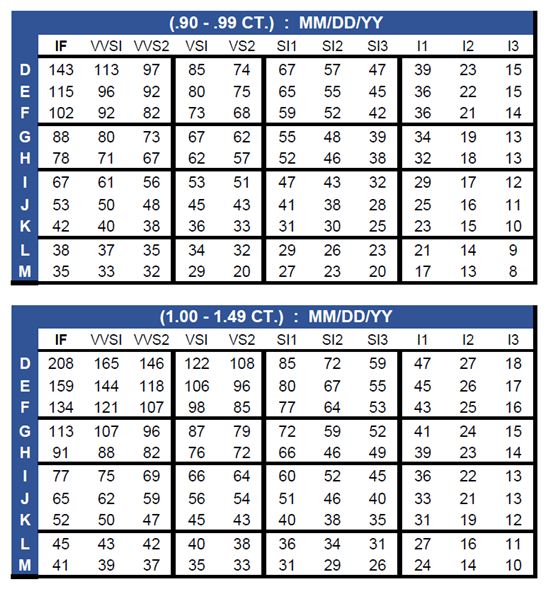 |
| Sample Diamond Price Chart |
| Note: this chart is for illustrative purposes only and does not reflect actual diamond prices. |
It's arranged in boxes of different carat weight groups. The numbers are by the hundreds (43 = $4,300). The price listed is per carat.
Problems with the Rapaport Chart
The Rapaport chart makes diamond pricing seem so simple. But there are some problems with it, which is why it shouldn't be used as the final say.
- The price is high. Rapaport itself says the price listed is the "high asking price." Retailers will generally apply a discount. Some jewelers will show you the Rapaport pricing and tell you that you're getting a "good deal" because they're selling for less. If you're unfamiliar with diamond prices, you may be fooled into believing that.
- It ignores cut. Rapaport prices are only based on carat, color, and clarity. We think cut is the most important factor, but it's not factored in. The pricing difference between different cut grades can be huge.
Instead of paying for a Rapaport, our diamond price charts provide a much better guideline for what diamonds currently cost. Or just search for diamond prices on sites like Brilliant Earth to get an idea of what a competitive price is.
Can You Buy Diamonds at Wholesale Prices?
Simply put, no, you cannot buy diamonds at wholesale prices. However, you can purchase a competitively priced diamond from a trustworthy online jeweler.
Wholesale means buying in bulk, at reduced prices, for the purpose of selling to consumers. Jewelers buy their diamonds wholesale and they need to cover operating costs and make a profit too, so they tack on their own markup.
Online jewelers can sell their diamonds at closest to wholesale prices. They have less overhead so they don't mark up as much.
So, be careful of jewelers who advertise wholesale for their diamonds. Unless you have a direct relationship with a diamond cutter, you can't buy at the same prices that jewelers buy for.
What Is Diamond Price-per-Carat?
You may have heard that diamonds are priced per carat. What does this exactly mean to you as a diamond shopper?
In the diamond industry, diamonds are valued per carat based on their qualities. The price-per-carat increases with bigger and rarer diamonds.
For example, a 0.5-carat diamond may cost $2,500 per carat. So the total cost of the diamond will be $1,250 (0.5 x $2,500). A 2-carat diamond may cost $9,000 per carat. The total cost of that diamond will be $18,000 (2 x $9,000).
But for everyday diamond shoppers, you won't be able to get ahold of the price-per-carat figures (unless you pay for a Rapaport, and we already know there are some problems with that).
Take two 1 carat diamonds, both with an Excellent cut, H color, and VS2 clarity.
- Diamond A is 1.03 carat and costs $5,400. The price-per-carat is $5,400 / 1.03 = $5,242
- Diamond B is 1.09 carat and costs $5,560. The price-per-carat is $5,560 / 1.09 = $5,100
Diamond B is actually less per-carat even though the overall price is more.
Factors That Determine Diamond Prices
Here are the main factors that impact how diamonds are priced. We have plenty of individual detailed guides, so feel free to read more.
- The 4Cs. The 4C's - carat, cut, color, and clarity - determine the quality of a diamond. Bigger diamonds will cost more. More flawless and colorless diamonds will cost more. Diamonds that are well-cut will cost more.
- Overall beauty. Even for diamonds for the same 4Cs, there can be a significant price difference. For example, one SI2 diamond can be eye-clean, while another is not. One oval diamond can have a huge bowtie, while another doesn't. The diamond that looks better to the eye will be more expensive.
- Certification. This so important that it's often considered the 5th C. Proper certification verifies the quality of the diamond. GIA and AGS are the world's two most reputable gemology labs, so diamonds certified by them will cost a little more. IGI and EGL certified diamonds cost less.
Even though they're a little more expensive, we only recommend GIA and AGS certified diamonds because these two labs are the most trustworthy.
- Fluorescence. Fluorescence is a natural effect of when a diamond shows a soft blue glow under UV light. There's usually no negative effect, but it's still seen as a bad thing. Because of that, diamonds with stronger fluorescence will cost less.
- Diamond shape. Round diamonds are the most desirable. They also waste more diamond rough when cutting. Therefore, round is the most expensive shape. Other diamond shapes (like oval, pear, cushion, etc.) can be 20% - 40% less.
- Origin. While blood diamonds are no longer a concern, the hard truth is that a lot of diamonds come from poverty-stricken countries. Diamonds that come from more responsible areas (like Canadian diamonds) will cost a little more.
- Natural vs. lab. Lab diamonds are getting more popular as an eco-friendly choice. They have the same properties as mined diamonds, just that the creation process is sped up in a lab. Lab diamonds can cost 30% - 50% less than mined diamonds of the same quality.
- Jeweler markup. And of course, as mentioned before, the biggest impact on pricing is how much the retailer ultimately sells for.
How to Get the Best Value Diamond
No matter what your engagement ring budget is, of course you want the best value. Here are some tips and secrets to get the most bling for your buck.
The key to getting the best value is to buy a diamond that looks flawless to the naked eye, even if it's not.
Diamonds are graded using special tools and all sorts of fancy lighting. In real life, no one is going to be examining your diamond under a microscope (especially since it'll be mounted on a ring!). So, you don't need top quality. You just need one that looks good.
Here are some tips on how to maximize your budget:
- Don't buy a full carat
It sounds really good to hit that full 1-carat mark, but you can save 20% if you buy a 0.9 carat diamond instead. Nobody will be able to tell the size difference. The same is true with half carats (buy 1.4 carat instead of 1.5).You need a size difference of about 20% in order to see a difference. You can use that guideline to purchase a slightly smaller diamond, and yet still appear about the same size.
The size difference between a 1 carat and 0.9 carat diamond is only 0.2 mm (equivalent to the thickness of a piece of paper). So don't spend the money on something you can't see. - Pick nearly colorless
Color refers to how much of a yellow tint is in white diamonds. But most people cannot see a slight yellow tint, so you don't need a colorless stone. We recommend H color as best value because the price is right, but it still looks white. - Eye-clean, but not perfect
Clarity refers to how many flaws are in the diamond. This C is the least important. Likewise, most people can't see tiny imperfections with their naked eye. We recommend VS2 clarity as the sweet spot. These diamonds are cheaper because there are small flaws but they can't be seen. - Don't compromise on cut
Cut refers to how well the diamond is cut to reflect light (NOT shape). This is the most important factor. A well-cut diamond will be more sparkly and beautiful. In fact, it can make the diamond so sparkly that it looks bigger and hides flaws. A win-win! - Consider another shape
Round diamonds are the most popular, but there are 9 other diamond shapes. Fancy diamond shapes are 20% - 40% less than round diamonds. Shapes like oval, princess, and cushion are modern and just unique enough to make a statement. - Don't write off fluorescence
Fluorescence isn't necessarily a bad thing. Because of the blue glow, it can even make slightly yellow diamonds appear whiter (like an I diamond can look like an H). So you can actually save 3% - 15% by picking a lower-color diamond with fluorescence. - Smart setting design
If you're looking for a ring that really packs a punch while on a more limited budget, the halo setting is a favorite choice. Thanks to the ring of small diamonds, you can choose a smaller center stone but still have it appear huge and super sparkly.
Diamond Prices Over Time
Historical data shows that diamond prices have increased on average 4% per year over the past 10 years. This seems to be mostly keeping in line with inflation. In the past few years, diamond prices have remained pretty steady, and even a little bit of a decrease.
In the early 2000s, an average-quality (H, VS2) 1-carat diamond was priced at $5,900 on Rapaport. In 2010, such a diamond was listed at $6,300, while it is $7,600 today.
However, just because a diamond's retail price increases over time, it doesn't mean that the diamond will have good resale value. Unfortunately, the resale market is weak.
As soon as you have purchased the diamond, the value has already gone down. And you will never be able to sell a diamond even close to what you paid. This is why diamonds shouldn't be considered investments.
Bottom Line
Our price charts should give you a decent starting point to get familiarized with diamond prices.
The next step is to view actual diamond prices from popular retailers like Brilliant Earth. From there, you'll be able to see if you're truly getting a fair price for your diamond.
Anna G is a research director at CreditDonkey, a diamond jeweler comparison and reviews website. Write to Anna G at feedback@creditdonkey.com. Follow us on Twitter and Facebook for our latest posts.
Note: This website is made possible through financial relationships with some of the products and services mentioned on this site. We may receive compensation if you shop through links in our content. You do not have to use our links, but you help support CreditDonkey if you do.
|
|
| ||||||
|
|
|








